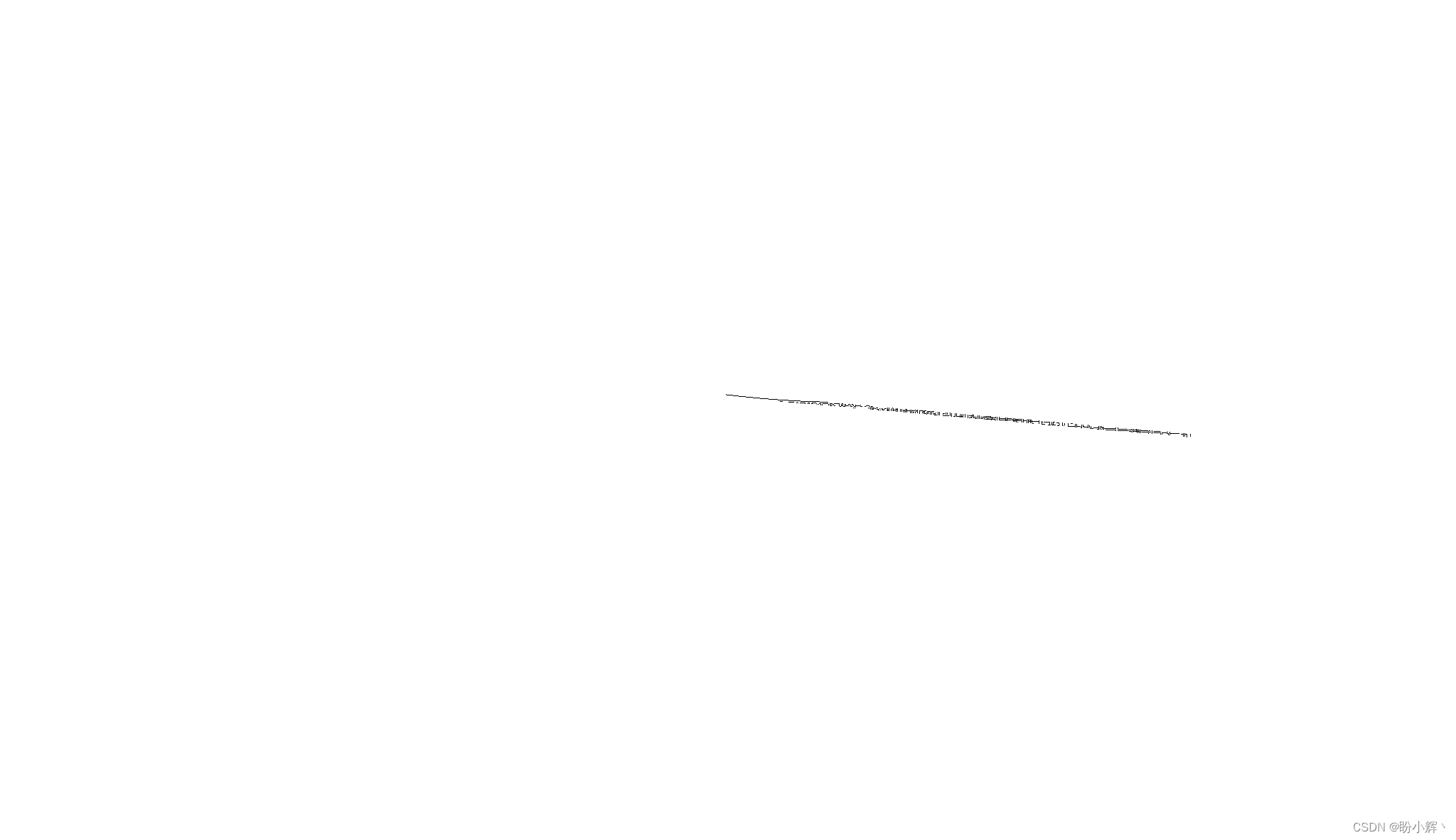OpenCV实战——拟合直线
-
- 0. 前言
- 1. 直线拟合
- 2. 完整代码
- 相关链接
0. 前言
在某些计算机视觉应用中,不仅要检测图像中的线条,还要准确估计线条的位置和方向。本节将介绍如何找到最适合给定点集的线。
1. 直线拟合
首先要做的是识别图像中可能沿直线对齐的点,可以使用霍夫变换检测到的线段。使用 cv::HoughLinesP 检测到的线段 lines 包含在向量 std::vector<:vec4i> 中。
(1) 要提取可能的点集,比如说,第 1 条线段,我们可以在黑色图像上绘制一条白线,并将其与用于检测线条的 Canny 轮廓图像相交:
int n = 0;
// 提取探测到的第一条线段的轮廓像素
cv::Mat oneline(image.size(), CV_8U, cv::Scalar(0));
cv::line(oneline, cv::Point(li[n][0], li[n][1]), cv::Point(li[n][2], li[n][3]), cv::Scalar(255), 3);
cv::bitwise_and(contours, oneline, oneline);
以上代码可以获得只包含可以与指定线关联的点,为了引入一些公差,我们绘制了一条一定粗细的线(线宽为 3),因此,在定义的邻域内的所有点可以都被接受。结果如下图所示(为了便于观察,反转图像像素值):

(2) 通过双循环将这个集合中点的坐标插入到 cv::Point 函数的 std::vector 中(也可以使用浮点坐标,即 cv::Point2f):
std::vectorcv::Point> points;
// 迭代像素以获得所有点位置
for (int y=0; yoneline.rows; y++) {
uchar* rowPtr = oneline.ptruchar>(y);
for (int x=0; xoneline.cols; x++) {
if (rowPtr[x]) {
points.push_back(cv::Point(x, y));
}
}
}
(3) 通过调用 cv::fitLine 函数很容易找到最佳拟合线段:
// 拟合直线
cv::Vec4f line;
cv::fitLine(points, line, cv::DIST_L2, 0, 0.01, 0.01);
以上代码以单位方向向量( cv::Vec4f 的前两个值)和线上一个点的坐标( cv::Vec4f 的后两个值)的形式提供线段方程的参数。对于示例结果,方向向量为 (0.83, 0.55),点坐标的值为 (366.1, 289.1)。cv::fitLine 函数的最后两个参数用于指定所需线段参数的精度。
(4) 线段方程可以用于计算某些属性,作为说明,我们可以在图像上绘制拟合的线。例如,绘制一个长度为 100 像素、宽度为 3 像素的黑色线段:
int x0 = line[2];
int y0 = line[3];
int x1 = x0+100*line[0];
int y1 = y1+100*line[1];
// 绘制直线
cv::line(image, cv::Point(x0, y0), cv::Point(x1, y1), 0, 2);
绘制结果如下图所示:

将一组点拟合为一条线是数学中的一个经典问题,cv::fitLine 函数通过最小化每个点到直线的距离总和来拟合直线。
可以使用不同的距离函数,欧几里得距离( CV_DIST_L2 ) 是最容易计算的距离,其对应于标准最小二乘线拟合。当点集中包含异常值(即不属于该线的点)时,可以选择其他异常点影响较小的距离函数。最小化基于 M 估计技术,该技术迭代地解决加权最小二乘问题,其权重与距离直线的距离成反比。
使用 cv::fitLine 函数,还可以将一组 3D 点集拟合为一条直线,此时,输入是一组 cv::Point3i 或 cv::Point3f 类型数据,输出类型为 std::Vec6f。cv::fitEllipse 函数可以将一组 2D 点拟合为椭圆,其返回一个旋转矩形( cv::RotatedRect 实例),椭圆内接于该矩形内:
cv::RotatedRect rrect= cv::fitEllipse(cv::Mat(points));
cv::ellipse(image,rrect,cv::Scalar(0));
cv::ellipse 函数用来绘制计算出的椭圆函数图像。
2. 完整代码
库文件 linefinder.h 和 edgedetector.h 可以参考线条检测一节,主函数 fitLine.cpp 代码如下所示:
#include 相关链接
OpenCV实战(1)——OpenCV与图像处理基础
OpenCV实战(2)——OpenCV核心数据结构
OpenCV实战(3)——图像感兴趣区域
OpenCV实战(4)——像素操作
OpenCV实战(5)——图像运算详解
OpenCV实战(6)——OpenCV策略设计模式
OpenCV实战(8)——直方图详解
OpenCV实战(11)——形态学变换详解
OpenCV实战(14)——图像线条提取
服务器托管,北京服务器托管,服务器租用 http://www.fwqtg.net

